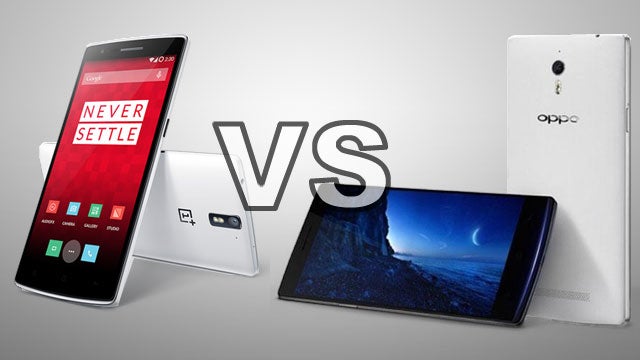OnePlus One vs Oppo Find 7a: What is different?

Cheap Androids Head-to-Head
The OnePlus One Android phone is one of the most exciting new phones of the moment. Some folk are more interested in this mobile than the Galaxy S5, the highest-profile Android of the year so far.
However, it’s partly based on an existing design, the Oppo Find 7a. And, looking a little deeper, OnePlus was setup by someone who used to work high up in Oppo Mobile.
Is this the same phone but with a different name on the back? There are some similarities, but here’s how the phones differ.
2.5GHz vs 2.3Ghz

The OnePlus One and Oppo Find 7a both have Snapdragon 801 processors. However, the OnePlus phone has a slightly faster chipset.
There are two main variants of the 801 – a 2.3GHz one and a 2.5GHz model. The Find 7a has the slower one, the OnePlus the nippier version.
We don’t think the faster clock speed is anything to get too excited about, though.
Touch On Lens screen tech

The OnePlus One has a TOL screen. If you haven’t heard of this before, don’t worry – it’s a pretty geeky tech term of which OnePlus is the main proponent.
TOL stands for Touch on Lens and it means OnePlus has done its best to remove space between the touch layer and the display panel. Samsung talked-up similar tech with its Super AMOLED screens in recent years.
OnePlus claims it makes the One 300 per cent more shatterproof than rivals. But we’re yet to see/try a drop test.
Oppo Find 7a has a memory card slot

Unusual for a super-geeky phone, the OnePlus One does not have an SD memory card slot. Instead you have to choose between 16GB and 64GB versions. There’s not a massive (£40) gap between the two, so the upsell is an attractive one.
The Oppo Find 7a does have a memory card slot, and at present there’s only a 16GB version, and when/if high-capacity versions turn up they may be a little rare. Not that any version of the Find 7a is going to be that common in the UK…
Different notification lights

These phones look pretty similar, but one key design difference is their use of notification LEDs. The Oppo Find 7a’s is a bit snazzier.
A bar along the bottom of the phone, below the soft keys, glows blue when you have a notification. It looks pretty cool, a little like some of Sony’s recent mid-range Xperias.
The OnePlus One notification LED is a bit more conventional, living in the screen bezel to the top of the phone’s front.
3100mAh vs 2800mAh batteries

There’s a slight difference in battery capacity between the Find 7a and One. The Find 7a’s is 2,800mAh, the OnePlus’s 3,100mAh.
However, the Oppo’s is actually a lot more interesting. Its charger uses VOOC tech that lets it charge up to 75 per cent from flat in 30 minutes. We reckon high-end rivals would take 3-4 times as long to do the same – it has been the norm in our recent tests.
The Find 7a’s battery is also removable while the OnePlus One’s is not. This makes replacing it a lot easier (in theory) should its capacity start to dwindle.
Oppo uses a custom interface, OnePlus uses CyanogenMod
Like most other phone makers, Oppo decided to put a custom interface on the Find 7a. While its core uses a fairly recent version of Android, we’re not huge fans of the look of what’s running on top.
It’s less ‘flat’ than standard Android and some of its visual tweaks are a bit dubious.
The OnePlus One uses a much plainer take on Android. It’s not entirely stock, but uses the community-based CyanogenMod software. It looks just like vanilla Android, but gives you a lot more access to the system without having to root your phone.
The OnePlus One is a lot cheaper

There are minor tech differences throughout these phones, but what it really comes down to is price. The OnePlus One is a lot cheaper than the Oppo Find 7a.
A 16GB version will cost you £229, the 64GB one £269. The 16GB version of the Find 7a costs £330, a cool £100 more. Of course, you do get some worthwhile extras including super-fast VOOC charging. But is it worth the extra? We’re not entirely sure.
Next, read our OnePlus One vs Nexus 5 comparison


